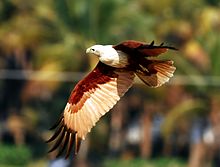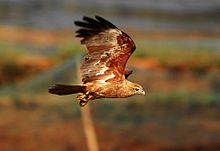Brahminy Kite
| Brahminy Kite | |
|---|---|
 | |
| Brahminy Kite near Chalakudy, India | |
| Conservation status | |
| Scientific classification | |
| Kingdom: | Animalia |
| Phylum: | Chordata |
| Class: | Aves |
| Order: | Falconiformes (or Accipitriformes, q.v.) |
| Family: | Accipitridae |
| Genus: | Haliastur |
| Species: | H. indus |
| Binomial name | |
| Haliastur indus Boddaert, 178 | |
The Brahminy Kite (Haliastur indus), also known as the Red-backed Sea-eagle, is a medium-sized bird of prey in the family Accipitridae, which also includes many other diurnal raptors such aseagles, buzzards and harriers. They are found in the Indian subcontinent, Southeast Asia and Australia. They are found mainly on the coast and in inland wetlands where they feed on dead fish and other prey. Adults have a reddish brown plumage and a contrasting white head and breast which makes them easy to distinguish from other birds of prey.
Description
The Brahminy Kite is distinctive and contrastingly coloured, with chestnut plumage except for the white head and breast and black wing tips. The juveniles are browner, but can be distinguished from both the resident and migratory races of Black Kite in Asia by the paler appearance, shorter wings and rounded tail. The pale patch on the underwing carpal region is of a squarish shape and separated from Buteo buzzards.
The Brahminy Kite is about the same size as the Black Kite (Milvus migrans) and has a typical kite flight, with wings angled, but its tail is rounded unlike the Milvus species, Red Kite and Black Kite, which have forked tails.The two genera are however very close.
The call is a mewing keeyew.
Taxonomy
The Brahminy Kite was first described by the Dutch naturalistPieter Boddaert in 1783. Four subspecies are recognized:
- indus (Boddaert, 1783) is found in South Asia
- flavirostris Condon & Amadon, 1954 is found in the Solomon Islands
- girrenera (Vieillot, 1822) is found in New Guinea, Bismarck Archipelago and Australia
- intermedius Blyth, 1865 is found in the Malay Peninsula and into the islands of the Sundas, Sulawesi and the Philippines
Distribution and status
This kite is a familiar sight in the skies of Sri Lanka, India, Pakistan, Bangladesh, and southeastAsia and as far south as New South Wales, Australia, through which region it is widespread and resident. They perform seasonal movements associated with rainfall in some parts of their range.
They are mainly seen in the plains but can sometimes occur above 5000 feet in the Himalayas.
It is evaluated as Least Concern on the IUCN Red List of Threatened Species. However the species is on the decline in some parts such as Java.
Behaviour
The breeding season in South Asia is from December to April.In southern and eastern Australia, it is August to October, and April to June in the north and west. The nests are constructed of small branches and sticks with a bowl inside and lined with leaves, and are sited in various trees, often mangroves.They show considerable site fidelity nesting in the same area year after year. In some rare instances they have been seen to nest on the ground under trees.A clutch of two dull white or bluish-white oval eggs measuring 52 x 41 mm is laid. Both parents take part in nest building and feeding but it is suggested that only the female incubates. The incubation period is about 26 to 27 days.
It is primarily a scavenger, feeding mainly on dead fish and crabs, especially in wetlands and marshland but occasionally hunts live prey such as hares and bats. They may also indulge inkleptoparasitism and attempt to steal prey from other birds. A rare instance of a bird feeding on honey at the hive of Apis florea has been recorded.
Young birds may indulge in play behaviour, dropping leaves and attempting to catch them in the air.When fishing over water, they may sometimes land in the water but manage to swim and take off without much trouble.
They roost communally on large and isolated trees and as many as 600 have been seen at just one location.
They may mob larger raptors such as the Aquila eagles. In some incidents where Brahminy Kites mobbed Steppe Eagles (Aquila rapax), they were attacked and injured or killed.
A number of ectoparasitic bird lice in the genera Kurodaia, Colpocephalum and Degeeriella have been reported.
In culture
Known as Elang Bondol in Indonesia, the Brahminy Kite is the official mascot of Jakarta. In India it is considered as the contemporary representation of Garuda, the sacred bird of Vishnu. In Malaysia, the island of Langkawi is named after the bird ('kawi' denoting an ochre-like stone used to decorate pottery, and a reference to the bird's primary plumage colour).
A fable from central Bougainville Island relates how a mother left her baby under a banana tree while gardening, and the baby floated into the sky crying and transformed into Kaa'nang, the Brahminy Kite, its necklace becoming the birds feathers.







No comments:
Post a Comment